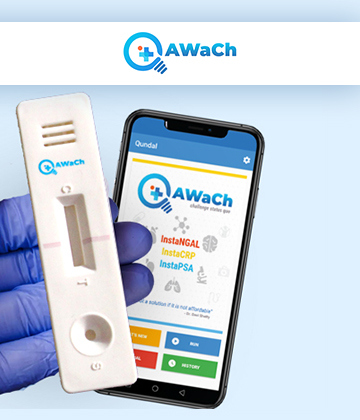Quantitative Lateral Flow Assay
A quantitative lateral flow assay (LFA) is a type of in vitro diagnosis that combines the simplicity and rapidity of lateral flow assay technology with the ability to provide quantitative results, either by using a portable reader or a smartphone.
Lateral flow assays are commonly used for point-of-care testing, as they are easy to use, portable, and do not require specialized laboratory equipment. raditional lateral flow assays, like pregnancy tests, yield qualitative results that usually indicate the presence or absence of a target analyte. In contrast, quantitative lateral flow assays strive to gauge the concentration or quantity of a particular analyte within a sample. In numerous medical conditions, comprehending the analyte or biomarker's concentration holds importance beyond a binary yes or no outcome.
What is Quantitative Lateral Flow Assay ?
The fundamental principle of a quantitative lateral flow assay relies on capture and detection antibodies, much like other antibody-based assays. This process involves immobilizing the capture antibody on a nitrocellulose membrane at a designated region known as the test line. The detection antibody attaches a signal-generating molecule, such as colloidal gold or enzymes. When applying a sample to the assay, the target analyte in the sample binds to the capture antibody, forming a complex.
This complex then migrates along the nitrocellulose membrane through capillary action. Upon reaching the test line, the detection antibody binds to the analyte, forming a sandwich-like structure. The test line captures the signal generated by the labeled detection antibody, and the intensity of the signal directly correlates with the concentration of the analyte in the sample. To quantify the results, a reader or imaging system measures the signal intensity on the test line. This measured signal is then compared to a calibration curve or reference standards to determine the actual concentration of the analyte in the sample.
QAWaCh Bio team has developed a first-of-its-kind quantitative lateral flow assay platform called ‘Q-Plat’ that uses a lateral flow assay test card and a smartphone application to give results within 10-15 minutes. A number of the company’s tests are based on this unique platform, including InstaNGAL®, InstaCRP, thyroid function tests like InstaTSH, InstaT3 and InstaT2, etc.

A quantitative lateral flow assay (LFA) represents a significant advancement in in vitro diagnostics, combining the simplicity and rapidity of lateral flow assay technology with the ability to provide quantitative results. This innovation enables the measurement of analyte concentration within a sample, offering more than a binary yes or no outcome.
Strength:
LFA's strength resides in its capacity to deliver quantitative results, vital in numerous medical conditions where comprehending the analyte or biomarker's concentration is crucial for effective diagnosis and monitoring. Furthermore, this technology significantly enhances the diagnostic capabilities of lateral flow assays.
Advantages:
LFA maintains the advantages of traditional LFAs, such as ease of use, portability, and freedom from specialized laboratory equipment. However, it goes a step further by providing quantitative data. Additionally, this innovation facilitates point-of-care testing with more informative and actionable results.
Recognitions:
The development of quantitative lateral flow assays is widely acknowledged for significantly contributing to point-of-care testing and in vitro diagnostics. This achievement represents an important milestone in the field, expanding the applications of LFAs. Furthermore, it opens new avenues for leveraging this technology in diverse healthcare scenarios.
Innovation:
QAWaCh Bio's 'Q-Plat' platform, utilizing LFA technology, exemplifies innovation in this field. Integrated with a smartphone application, this platform provides rapid results within 10-15 minutes for various tests, including InstaNGAL®, InstaCRP, and thyroid function tests like InstaTSH, InstaT3, and InstaT2, among others. This innovation significantly enhances accessibility to quantitative diagnostic information and ultimately improves patient care. Moreover, it showcases the potential for transformative advancements in point-of-care diagnostics.
